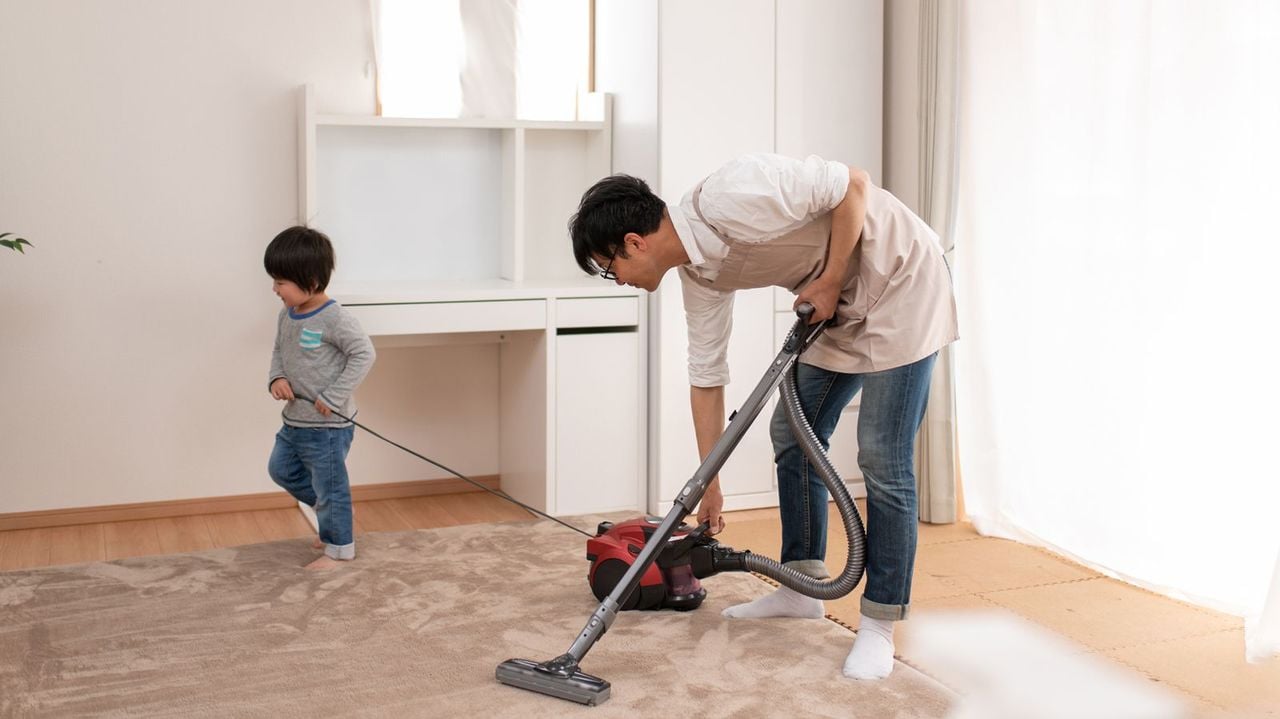
For some countries, it may be almost over. Not for the US. As coronavirus cases and fatalities are rising, difficult decisions are being debated: Can schools open safely in the fall? Should shelter in place orders be reinstated? Is the phased reopening of businesses successfully reigniting the economy?
As daunting as these questions are, one thing remains certain. With canceled summer camps and the near certainty of virtual learning, more is being required of working parents. Dads are no exception.
Many of us can recall when the ‘BBC Dad’ interview went viral in 2017. Robert Kelly, a father of two, was being interviewed about the intricacies of politics on the Korean peninsula when his four-year-old daughter sauntered in, followed by her baby brother.
This live video garnered a lot of attention because it highlighted the difficulties of dads working from home, especially with young children. During this pandemic, this is no longer an amusing meme. It is a fact of daily life.
According to the U.S. Bureau of Labor Statistics, the labor force participation rate for men (age 20 to 64) was 67.2% as of July 2, 2020 compared to 56.1% for women. The Global Workplace Analytics (GWA), which specializes in helping organizations and communities make the business case for emerging workplace strategies such as flexible work or telecommuting, estimates that 55% of the U.S. workforce is employed in a field partially compatible with remote work. In a joint CNBC/Change Research survey conducted in April, 42% of Americans polled reported they were working from home.
This means that more dads will continue working from home, alongside their spouses. How does this affect home life, particularly during this time?
A pandemic magnifies all existing inequalities. In many households, men are more likely to earn more than women, meaning their jobs are considered a higher priority when major disruptions occur.
In a recent report from the Boston Consulting Group, just over a third of parents say women are the primary caregiver, while only 14% agree that it’s men. Women are spending an average of 15 hours more per week than men on domestic labor during the pandemic. This means that for many dads working from home, not much has changed during COVID-19.
According to Daniel Carlson, an associate professor of family and consumer studies at the University of Utah, Salt Lake City, the vast majority of men in the U.S. want to share housework and childcare with their partners. However, structural barriers like a lack of job flexibility and time at home have prevented this. This barrier has now been lifted by the pandemic. Are men doing more around the home?
“I periodically worked from home before COVID-19, and when I was home, I picked up more household work,” said Johan S., a Facebook software engineer. “During COVID-19, “pick up more household work,” has become fixed as it has lasted long enough to let us fall into routines.”
This has allowed Johan and his wife and kids (13 and 10) to distribute household tasks, although his wife still does more housework than he does. The biggest difference COVID-19 has had is in “spreading a little bit more household work on to the kids, who are not in school all day.”
Their routine includes each family member doing their own laundry, Johan washing the dishes, and his wife cleaning the floors with help from the kids. Childcare has largely been, “Johan is on point for the kids until he goes to work and after he gets out of work.” His wife then has primary care of the kids, making sure they dial in to their Zoom classes and complete their homework.
To make this schedule seamless, Johan doesn’t go to work (including checking work email) until 9 a.m., and he usually stops working (likewise avoiding work email, etc.) by 6 p.m. Since his wife’s work as a photographer has become more structured during Covid-19, she similarly has clear starts and stops. This has allowed them to have a cohesive family schedule.
“My work-life balance is much better right now,” he said.
Previously, he would leave for work around 7:20 a.m. and get home around 6:50 p.m. Now he rarely gets out of bed by 7:20 a.m. and he’s done by 6 p.m. This new schedule means that instead of spending his “me time” commuting on the ferry and drinking coffee or reading a book, he now has breakfast with his kids and takes long walks in the evening with his wife.
“It has changed my non-work-time allocation more than my work-time allocation.” Overall, this new schedule has given him more time in the day.
Johan’s experience corresponds with what Flexjobs, a job search website, found about working remotely. 75% of respondents said they are more productive working from home due to fewer distractions. What about single dads or those with younger children?
Todd Youngblood, co-founder & COO of Kryo Inc. and married father of four explained the dilemma of a friend who’s raising two girls under six as a software engineer.
“He’s really struggling to find the focus time to do the deep work his job requires,” he said. “He has a limited support network and certainly has had to deal with the woes of single moms.”
Although less overwhelming, his struggles can be shared by stay-at-home dads who are primary caregivers of young children.
In a June 19, 2020 NBC News segment entitled, “Fatherhood in the Pandemic: Dads Married to Doctors,” several fathers shared their experience. One of them was Curtis Webster Jr., who’s married to an emergency room doctor and works as both a stay-at-home father to his daughters, ages 5, 7 and 11, and a remote business owner in IT and support.
“At the start of the year, we were working on how to spend more time with our children and build a better work-life balance,” he said. “The pandemic threw those goals off course.”
Webster was already in the process of understanding his daughters’ unique personalities, how they handled different situations, and their general learning habits.
"I would go to the schools when I could,” he said. “I would go and visit them for lunches and volunteer, but seeing them firsthand and being that teacher and having to jump into that role was definitely something I had to rise to.”
Another dad in the segment was Chris McGilvery — a 35-year-old father of two young boys, ages 1 and 5 — who works as an instructional designer for online courses. McGilvery has been the primary caregiver during the pandemic because his wife just completed her residency in family medicine.
“During quarantine we’re trying to figure it all out – do we have schedules; do we not?” he said. “Cheers to all the dads for stepping up during the pandemic and being there for [their] families.”
This is not true for all dads. Allyson Downey, CEO and founder of Stellar Reviews, a consumer review service that has been conducting weekly surveys of thousands of consumers during the pandemic, found that men are handling more of the regular chores like dishwashing, laundry, or taking out the trash.
Her analysis showed that women are still doing more cooking and cleaning than usual and bearing most of the childcare and home-schooling responsibilities.
“I had been hoping we’d see a normalization of roles with this situation,” Downey said. “But looking at the data showing how many more women are spending more time than usual on schoolwork, I don’t know. What stood out to me is that maybe the dads are stepping in with regular chores, but the mental load is still falling on women disproportionately.”
Todd Youngblood, father of four boys – 11, 17, 19 and 21, would agree.
As a co-owner of a global business, Youngblood has enjoyed being home with his family. But it’s not always easy.
“During the times my wife had a packed schedule, I would help my 11 and 17-year-old with their scheduled work,” he said. “It didn’t take long before I was frustrated and so were they, and it certainly didn’t contribute to a good working environment for my wife.”
Due to this, it was decided that his wife was better off managing the boys while he stayed in his office “doing his thing.”
The upside is that they’ve had more opportunities to spend time having lunches and dinners together this year more than the last ten. Their two older boys were also home, “making for [their] larger than reasonable group a lot of fun.”
Johan S. also found that a lack of clear discussion about handling childcare and home duties led to some initial discomfort.
“We didn’t communicate often or well enough, based on the [misunderstandings].”
Johan said they’ve become better at respecting each other’s space and privacy by necessity.
“At first there was unpredictable bickering, but within a few weeks we’d pretty much worked out how to provide each other space while being in the same house all the time.”
Communication was key.
This is what Carolyn Dayton, PhD of the Wayne State University School of Social Work, recommends. As a researcher focused on early parenting processes with an emphasis on fathering in urban settings, she has helpful suggestions in her article entitled, “Parenting Tips for Dads during the Covid-19 Crisis.”
“Talk openly and directly about routines, daily structure, discipline, and other parenting tasks with your parenting partner,” she said. “Make a plan to share the load – decide who’s in charge during each part of the day.”
To effectively do this, she suggests taking “shifts” so that each partner has time to focus on work, self-care, or other tasks. This allows for support during this pandemic.
“All of this family time can be tiring, and each parent will need time to take care of their own needs.”
Communicating openly and effectively is especially paramount during this period, but most of all, “give your parenting partner – and yourself – some grace. Remember that we are all doing our best during this challenging time.”
Dayton emphasizes that as a dad, now is the occasion to offer more cuddles and kind words so that your kids feel a sense of safety and security.
Dads understand this role. But society’s expectation for them to be the provider brings conflicting expectancies. Kristin Kim Bart, senior director of gender equality for the International Rescue Committee sees the issue as a societal one. She said that where women have been “stepping up and working” it’s seen a social promotion. But when men are focused on household chores “it risks being seen as a social demotion for a lot of them. Men’s identities are still tied to being a provider.”
So what’s the essential responsibility for men during this pandemic?
Johan S. believes his role as a father during COVID-19 is to spend quality time with his wife and children, which he’s now able to do.
“I actually like my family, so being around them is a good thing for me.”




